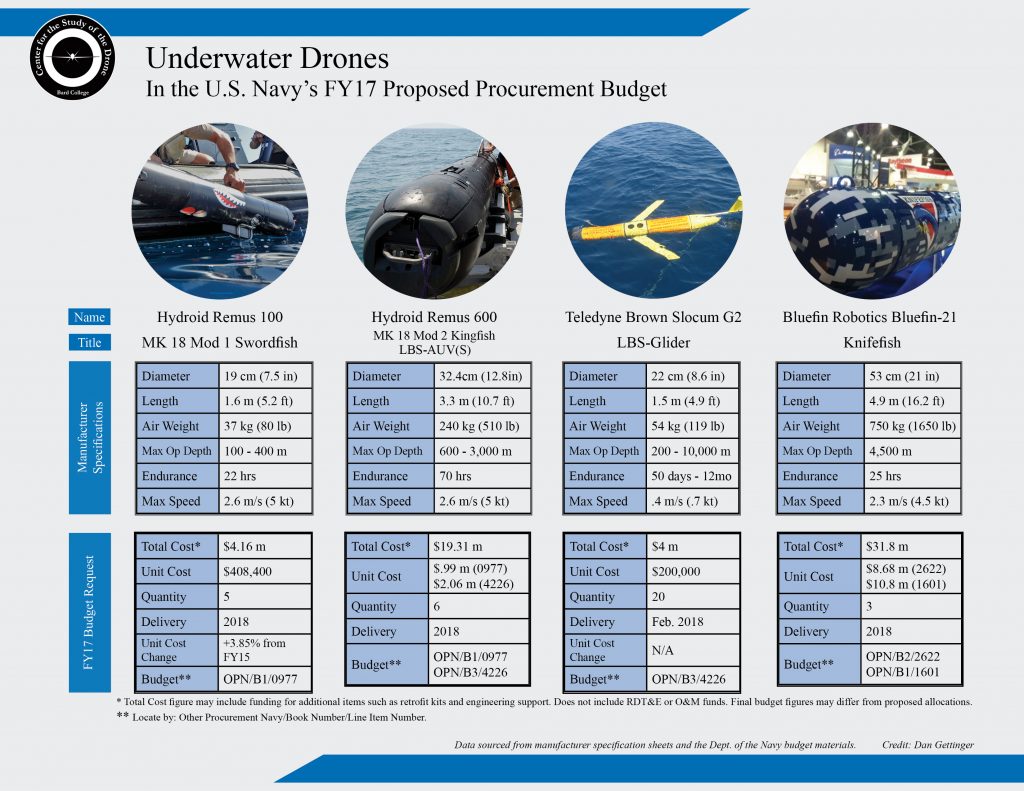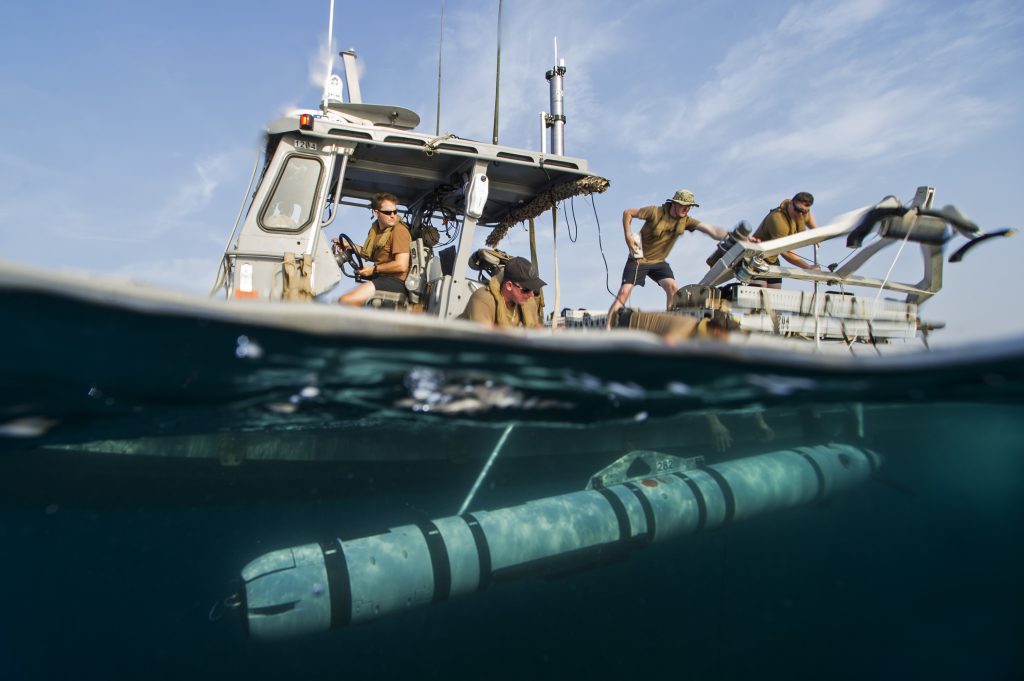
By Dan Gettinger
This article is adapted from a post from November 2015 and includes recent developments and updated spending figures.
In October 2016, the U.K. Royal Navy hosted Unmanned Warrior, a massive exercise involving 18 nations that focused on operations involving unmanned air, ground, and maritime vehicles. Popular Mechanics called the exercise the “world’s biggest robot war games.” The Unmanned Warrior exercise offered perhaps the highest profile test to date of an emerging class of unmanned systems: underwater drones, also known as unmanned undersea vehicles (UUV) or autonomous undersea vehicles (AUV). The development of such systems is a major priority for the U.S. Navy and navies around the world. These drones, some of which could eventually be capable of remaining submerged for months at a time, will serve in a variety of roles, including anti-submarine warfare and mine-hunting.
According to the Autonomous Undersea Vehicle Applications Center, a non-profit industry advocacy organization, there are 255 unique configurations of UUVs in service today, including 147 different vehicle platforms. That number is likely to grow in the coming years as the technology improves. Here’s what you need to know about UUVs:
Background
There are two types of unmanned submarines: remotely operated underwater vehicles (ROVs) and unmanned undersea vehicles (UUVs). ROVs are generally tethered vehicles that are piloted by crew members above the surface, while UUVs are not tethered and are designed to operate for longer periods of time and at greater distances from the operator than ROVs. In 1957, the University of Washington’s Applied Physics Laboratory, with support from the Office of Naval Research, developed the Special Purpose Underwater Research Vehicle (SPURV). One of the first UUVs, the SPURV could dive up to 10,000 feet and operate for four hours. By the time the SPURV program ended in 1979, other ROVs and UUVs were being developed in the United States, particularly for marine exploration and research. In 1985, the Argo, a remotely operated underwater vehicle, found the wreckage of the Titanic and, a World War II battleship called the Bismarck in 1989.
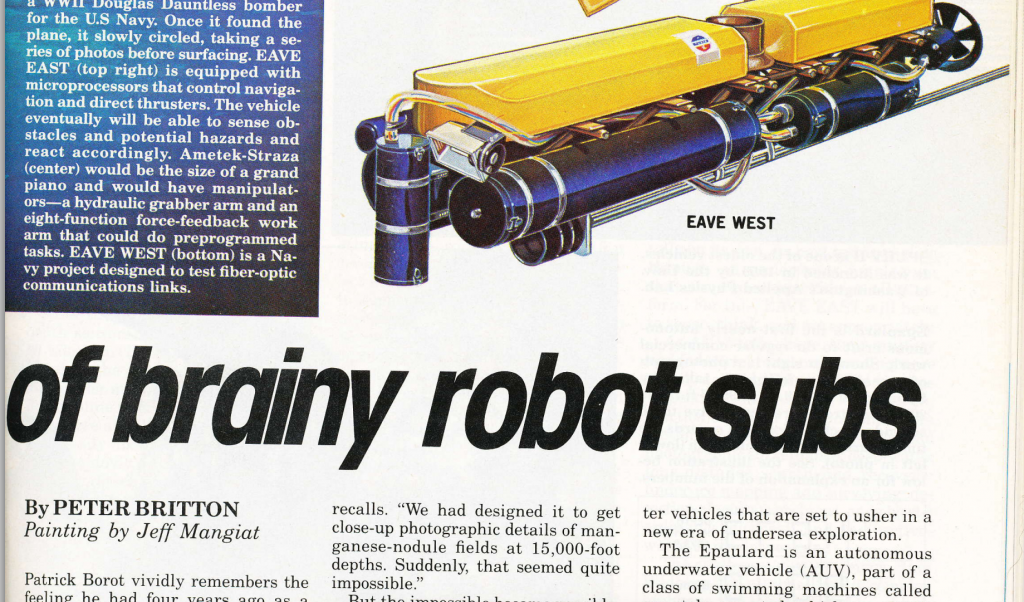
After the Soviet Union mistakenly shot down Korean Airlines 007 in 1983, the U.S. Navy deployed the Deep Drone, a remotely operated vehicle built by Eastport International, to aid in the search for the “black box” of the passenger plane. In 1999, the Deep Drone was used again, successfully locating the flight recorders of EgyptAir 990 off the coast of Nantucket Island. In 2011, a team from Woods Hole Oceanographic Institute used UUVs to help find the wreckage of Air France 447. Underwater drones have been repeatedly sent to aid the search for Malaysian Airlines 370; most recently in October 2016 when a Chinese vessel was outfitted with a remotely operated vehicle for deep sea exploration.
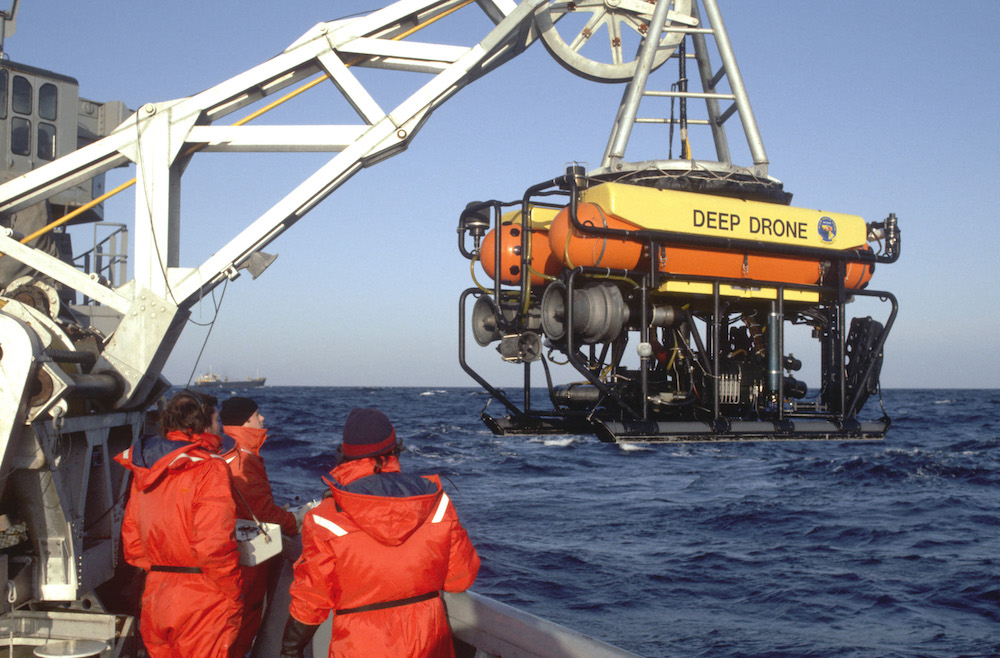
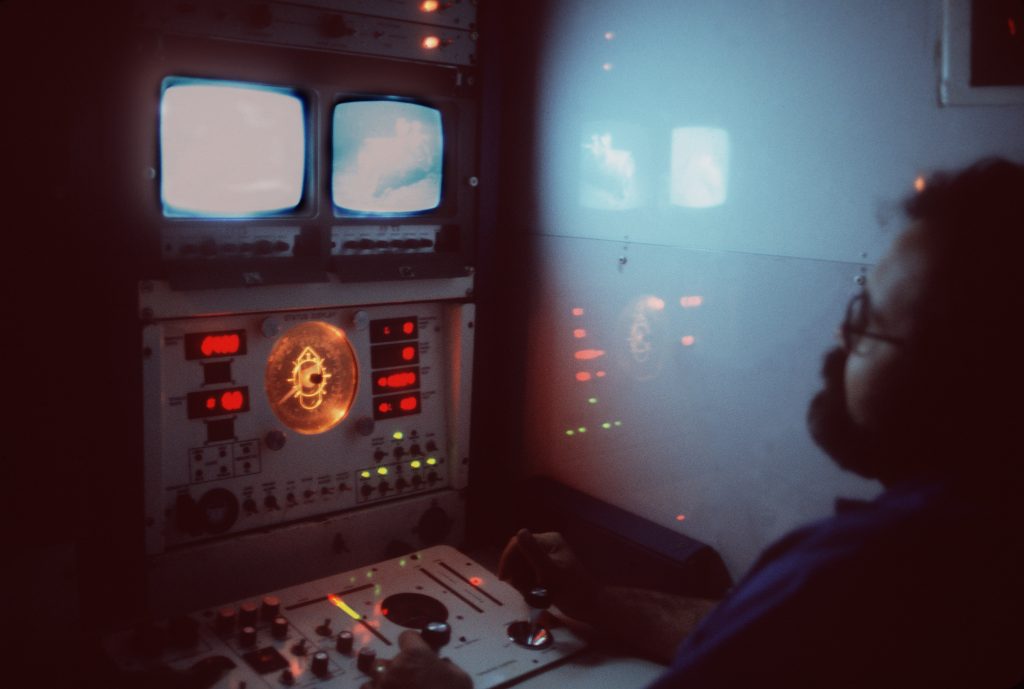
As a September 2015 article in the New York Times pointed out, due to the lower operating costs and the ability to stay underwater for extended periods of time, ROVs remain an extremely attractive option for deep sea researchers. In recent years, a new generation of underwater drones have allowed both universities and small businesses access to new opportunities for undersea exploration in the same way that unmanned aerial vehicles have democratized access to the sky. Startup companies like Blue Robotics and OpenROV have utilized off-the-shelf hardware to create ROVs that are a fraction of the cost of those used in locating the Titanic and the Bismarck. In July 2016, an OpenROV team used one of their underwater drones to get a closer look at steamship Tahoe, an early 20th-century wreck in Lake Tahoe.
In the 1990’s, after two U.S. Navy ships were badly damaged by Iraqi sea mines in the Persian Gulf during Operation Desert Storm, the Navy began investing heavily in Mine Countermeasures and initiated a program to build UUVs that could disable enemy sea mines. The Navy’s 1994 Unmanned Undersea Vehicle (UUV) Plan set the priorities for the program; topping the list was the need to develop UUVs for organic and clandestine mine detection. In other words, the Navy needed a system that could avoid detection by operating underwater and in advance of dedicated minesweepers on the sea surface. In 1996, Northrop Grumman developed the Near-Term Mine Reconnaissance System, a two-vehicle platform that was designed to be launched from the torpedo tube of a submarine and connected to the vessel by a fiber-optic tether. The NMRS was replaced by the Long-Term Mine Reconnaissance System. The LMRS program produced the 20 ft.-long Boeing AN/BLQ-11 drone.
The UUVs of Today
In the years since the Navy’s first serious foray into UUVs with the NMRS and LMRS, a number of underwater drones with varying capabilities have emerged. With the release of the Unmanned Undersea Vehicle Master Plan in 2004, the Navy established nine priorities for future UUV capabilitie, ranging from anti-submarine warfare to delivery supply and even strike missions. Among the most prolific unmanned undersea drones are the Remote Environmental Monitoring UnitS (REMUS) family of UUVs. The REMUS product line was developed by Woods Hole Oceanographic Institution and Hydroid, a Massachusetts-based UUV manufacturer that is now owned by Kongsberg Maritime. During Operation Iraqi Freedom in 2003, a REMUS 100 UUV was used to help clear sea mines from the waterways around the port of Umm Qasr, marking the first time a UUV was deployed in a combat environment. The larger, more capable REMUS 600 is a torpedo-shaped underwater drone designed to carry a large payload of sensors down to a depth of 600 meters for meteorological and oceanographic surveying. The Kingfish, a U.S. Navy variant of the REMUS 600, is expected to replace the U.S. Navy’s Marine Mammal Program, an effort to use dolphins and sea lions to detect sea mines, within a few years.
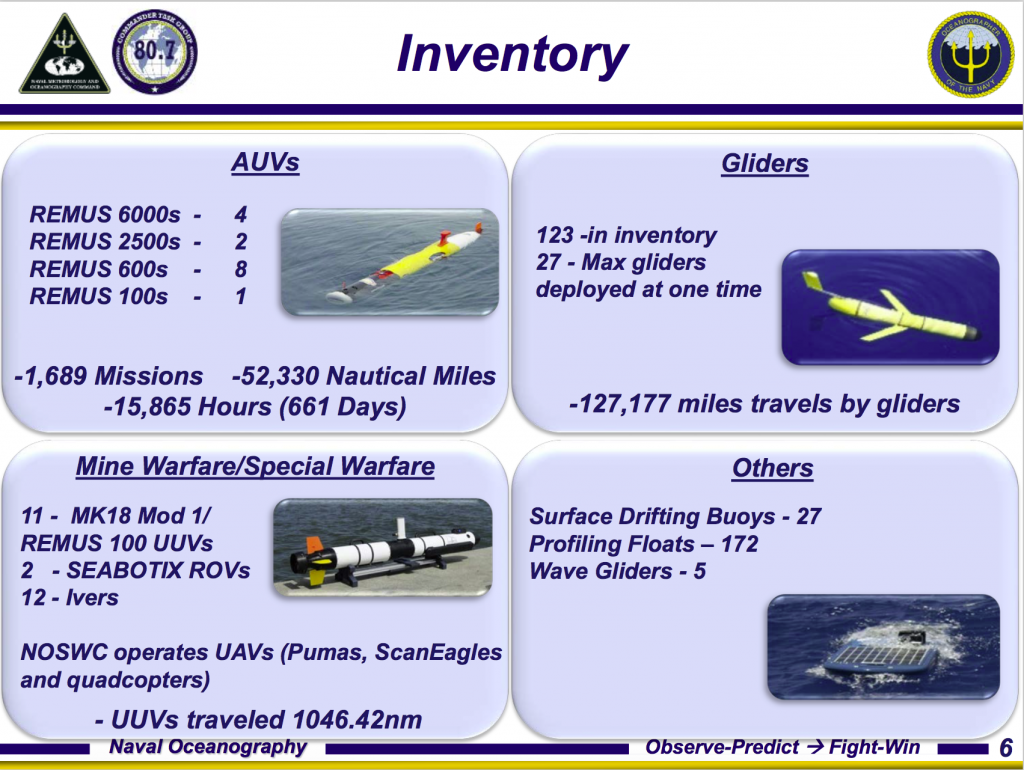
Mine countermeasures (MCM) remains the top priority for the Navy’s UUV programs. The Navy traditionally fields an array of air and sea systems to counter enemy mines, including fleets of minesweepers and low-flying helicopters that use sonar to detect mines. The Navy is investing in maritime unmanned systems to replace the manned vehicles used for the MCM mission. It has decided to couple unmanned mine countermeasures to existing manned vessels, including to the new Littoral Combat Ship (LCS), creating the MCM “module” for the LCS. Instead of sending out human divers, UUVs can be used to disable the devices with a small explosive charge, eliminating the risk to sailors. UUVs are also fitted with sonar and other sensors that can autonomously map out minefields. The Navy is under pressure to develop and deploy UUVs, as existing platforms like the Avenger-class minesweeper and the Sea Dragon helicopters are quickly reaching the point of retirement.
In Fiscal Year 2017, the Department of Defense is anticipated to spend at least $350 million on underwater drone procurement and research. Most of this funding is concentrated in Navy programs, with additional funds for UUV research allocated by the Defense Advanced Research Projects Agency and the Office of the Secretary of Defense. The Navy will transition some UUV projects from the research to the procurement stage, marking a significant development in the plan to acquire UUVs. Since some UUV research projects are packaged within larger line items, however, the total amount the DoD will spend on underwater drones is likely more than $360 million. For example, a large portion of the Navy’s $77.2 million research project into anti-submarine warfare surveillance technologies will go toward underwater drone technology.
The Navy’s 2017 UUV procurement efforts are divided into packages like mine countermeasures and meteorological equipment. For the underwater explosive ordnance disposal package, the Navy intends to spend a total of $21 million on a few different types of unmanned undersea vehicles: the Hydroid MK18 Mod 1 Swordfish, MK18 Mod 2 Kingfish, and Bluefin Robotics HULS ROV. Under the program to deliver a replacement for manned minesweepers, the Navy will purchase two General Dynamics Knifefish UUVs for a total of $20.5 million. Finally, under the Meteorological Equipment program, the Navy will purchase 20 Littoral Battlespace Gliders from Teledyne Brown Engineering and four Autonomous Undersea Vehicles from Hydroid for a total of $22.45 million.
The mine countermeasures package for the Littoral Combat Ship has been one point of contention in recent years between the Navy and Congress. In Fiscal Year 2017, the Navy will purchase one General Dynamics Knifefish UUV for mine countermeasures for the Littoral Combat Ship. It will not, however, devote funds for the Remote Minehunting System, which was officially cancelled by the Navy in March 2016. The main product of the RMS was Lockheed Martin’s Remote Multi-Mission Vehicle (RMMV), an autonomous UUV that was intended to be deployed from a Navy ship to help search for mines by towing a sonar. The concept for the RMS was actually developed in the late 1990s, and it has had a checkered history. According to the latest Selected Acquisition Report for the RMS, the acquisition cost of a single system has more than doubled from $13 million to $27.7 million between 2007 and 2015.
In September 2015, Senators John McCain and Jack Reed criticized the Navy’s Remote Minehunting System program, arguing that the RMMV had failed to meet requirements and could be scrapped altogether. “Put simply, while estimated overall spending on RMS is only a little higher than originally planned, it is only yielding half the number of systems, at more than double the unit cost, and it is taking twice as long to field it,” Senator McCain wrote in a review of the RMS program. “Also, it doesn’t work,” he added. Although RMS is no more, the AN/AQS-20A advanced minehunting sonar that was developed for the RMMV will be funded in Fiscal Year 2017.
The Next Generation of Underwater Drones
Defense funding for research into UUVs is around three times more than funds for procurement. Some of these research programs are dedicated to UUVs that the Navy is currently purchasing like the General Dynamics Knifefish UUV, which is slotted to receive $11.6 million in research funding in FY17. However, the Navy and other DoD departments have allocated considerably more funds toward researching the next generation of UUV systems and technologies. The largest of these research programs are for the Large Displacement Unmanned Undersea Vehicle (LDUUV) and the Extra Large UUV (XLUUV). Unlike UUVs intended for a specific mission such as detecting sea mines, these larger UUVs are designed to have multiple mission types, including persistent intelligence gathering capabilities and payload delivery.

The essential difference between the LDUUV and XLUUV has to do with the fact that LDUUVs, like existing UUVs, are intended to be deployed from Navy ships, while the XLUUV could be deployed from a Navy base and operate independently of a host vessel. The LDUUV-class UUVs will have a hull diameter of more than 36 inches, while the XLUUV will have a maximum diameter of 54 inches. (The majority of UUVs generally have a hull diameter of between 7 and 21 inches.) The LDUUV will have an endurance measured in weeks, while the XLUUV will be deployed for long range missions, traveling for months at a time and up to 2,000 nautical miles, according to a September 2016 request for information. In anticipation of the Navy’s demand for large UUVs, some companies are already independently investing research dollars into developing the next generation of underwater drones. In March 2016, Boeing unveiled the Echo Voyager, a massive 51-foot-long UUV that could potentially operate autonomously for months at a time.
In Fiscal Year 2017, the Navy plans to invest $67.6 million in researching LDUUVs and $78.6 million in a new research program dedicated to developing the XLUUV and associated technologies. The Navy has proposed purchasing five demonstrator XLUUVs in Fiscal Year 2017. However, this number could be reduced by Congress in the Fiscal Year 2017 National Defense Authorization Act. In the Senate’s NDAA report from earlier this year, it took issue with this proposal, suggesting that the cut the research program by $34.4 million by only purchasing two XLUUVs.
Beyond developing larger UUVs, one important area of focus is on improving the ability of unmanned systems to communicate and operate between air, surface, and undersea domains. For example, just as manned ships and helicopters currently collaborate to locate and destroy sea mines, unmanned helicopters like the MQ-8 Fire Scout could work with unmanned surface and undersea vehicles to accomplish the same mission while keeping human operators out of harm’s way. At the Annual Naval Technology Exercise in August 2016, several U.S. defense firms demonstrated how unmanned systems could work collaboratively between the air, surface, and undersea domains. An AeroVironment Blackwing UAV communicated with a swarm of unmanned undersea vehicles and Lockheed Martin successfully launched a UAV from a Marlin MK2 autonomous underwater vehicle. Northrop Grumman paired UUVs with unmanned surface vehicles and a Fire Scout UAV.
The Department of Defense has allocated funding for more experimental UUV programs, sometimes within larger line items. In Fiscal Year 2017, the Defense Advanced Research Project Agency has allocated $24.2 million towards the Hydra, project to develop a network of unmanned underwater assets that could be deployed quickly in response to emerging threats. Another project, the Upwards Falling Payloads program, is slotted to receive $14 million in FY17. The goal of this initiative is to design affordable unmanned systems that, when remotely activated, can rise to the surface to deliver either a waterborne or airborne payload of explosives or supplies. The Office of the Secretary of Defense also funds UUV research projects, although on a smaller scale than the Navy and DARPA. OSD’s Undersea Warfare and Technology Focus Area, for example, will receive $7.5 million for general research into UUV issues such as command and control and communications.
Future of the Field
Recent advances in UUV technology and affordability and geostrategic interests are among the factors driving interest in underwater drones at home and abroad. Other countries are pursuing UUV programs in the race to develop and field unmanned systems. In 2014, the Yomiuri Shimbun reported that Japan and the U.S. were collaborating on a 33-foot-long UUV that would be used to autonomously patrol areas using sonar. A RAND report on Chinese drones released earlier this year found that Beijing is funding at least 15 different university research programs into unmanned undersea and surface vehicles with particular emphasis on UUV projects. A Russian news broadcast in November 2015 confirmed suspicions that Russia was building a long-range UUV capable of carrying a nuclear warhead. In October 2016, the U.K. and France announced that they had awarded a $164 million contract to a group of European defense firms to develop a UUV for mine countermeasures.

Unmanned submersibles could provide a low-cost alternative to manned platforms for missions that are particularly dangerous, like minesweeping, or for mission that are tedious, like patrolling. UUVs, particularly those envisioned by DARPA, could also be a way to assert military presence in an area that is difficult to reach or geopolitically contentious. Like the minesweeper concepts, UUV platforms could be built into the capabilities of existing manned platforms like the Littoral Combat Ship or submarines. Alternatively, larger UUVs may be deployed from ports and conduct missions independent from manned ships.
However, as a 2009 RAND study of UUV systems pointed out, some of the Navy’s proposed UUV missions were not practicable and remain out of reach. Issues with reliability, specifically within the realms of power systems and underwater communications, suggested to the RAND researchers that the technology was not quite mature enough. The controversy over the Remote Minehunting System is one example of how the Navy has struggled to develop an adequate countermine alternative to minesweepers and to successfully sell UUV technology to lawmakers on Capitol Hill. While UUVs present significant advantages in terms of cost and safety over manned platforms, it will be some years before UUVs are accepted into the fleet.
For updates, news, and commentary, follow us on Twitter.
[includeme file=”tools/sympa/drones_sub.php”]

